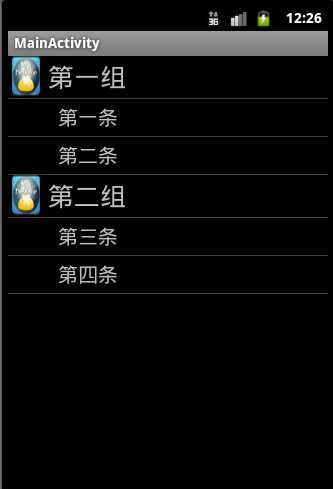标签:
1.设置ExpandableListView 默认是展开的:
先实例化exListView 然后
exListView.setAdapter(exlvAdapter); //遍历所有group,将所有项设置成默认展开 intgroupCount = exListView.getCount(); for (inti=0; i<groupCount; i++) { exListView.expandGroup(i); };
2.只展开一个组,关闭其他组,expandablelistview响应onGroupClick监听:设置expandablelistview.setOnGroupClickListener()
折叠和展开事件,可以设置setOnGroupCollapseListener和setOnGroupExpandListener
exListView .setOnGroupExpandListener(new OnGroupExpandListener() { @Override public void onGroupExpand(int groupPosition) { for (int i = 0, count = onlineUsersListView .getExpandableListAdapter().getGroupCount(); i < count; i++) { if (groupPosition != i) {// 关闭其他分组 exListView.collapseGroup(i); } } } });
3.默认展开第一个分组:
exListView.expandGroup(0);
4.去掉ExpandableListView 默认的箭头
exListView .setGroupIndicator(null);
5.将默认的箭头修改到右边显示:
(1)首先ExpandableListViewelistview;
exListView.setGroupIndicator(null);//将控件默认的左边箭头去掉,
(2)在自定义的继承自BaseExpandableListAdapter的adapter中有一个方法
/** * 父类view */ @Override public View getGroupView(intgroupPosition, booleanisExpanded, View convertView, ViewGroup parent) { Log.i("zhaoxiong","parent view"); LinearLayoutparentLayout=(LinearLayout) View.inflate(context, R.layout.wowocoupons_parent_item, null); TextViewparentTextView=(TextView)parentLayout.findViewById(R.id.parentitem); parentTextView.setText(parentlist.get(groupPosition)); ImageViewparentImageViw=(ImageView) parentLayout.findViewById(R.id.arrow); //判断isExpanded就可以控制是按下还是关闭,同时更换图片 if(isExpanded){ parentImageViw.setBackgroundResource(R.drawable.arrow_down); }else{ parentImageViw.setBackgroundResource(R.drawable.arrow_up); } return parentLayout; }
6.expandablelistview的Group点击事件,onGroupClick的返回值false展开,true不展开
exListView.setOnGroupClickListener(new OnGroupClickListener() { @Override public boolean onGroupClick(ExpandableListView parent, View v, int groupPosition, long id) { IsFlag=true; if(adapter.getGroupData().get(groupPosition).getList().size()==1){ Bundle b=new Bundle(); b.putInt("saveIndex", 0); b.putSerializable("datalist", adapter.getGroupData().get(groupPosition).getList()); Intent i=new Intent(WappushBindingActivity.this,VideoPlayerActivity.class); i.putExtras(b); startActivity(i); } // int groupCount = tt_list.getCount(); // for (int i=0; i<groupCount; i++){ // if(i!=GroupPosition) // tt_list.collapseGroup(i); // }; // Log.v("xulongheng*WappushBind*tt_list", "onGroupClick:"+previousX+"/"+previousY); return true; //默认为false,设为true时,点击事件不会展开Group } });
7.demo:
效果:

布局文件
main.xml
<LinearLayout xmlns:android="http://schemas.android.com/apk/res/android" xmlns:tools="http://schemas.android.com/tools" android:id="@+id/LinearLayout1" android:layout_width="match_parent" android:layout_height="match_parent" android:orientation="vertical" > <ExpandableListView android:id="@id/android:list" android:layout_width="match_parent" android:layout_height="match_parent" style="@style/myExpandableListView" android:drawSelectorOnTop="false" /> <TextView android:id="@id/android:empty" android:layout_width="match_parent" android:layout_height="match_parent" android:text="no data" /> </LinearLayout>
第一级条目布局
group.xml
<?xml version="1.0" encoding="utf-8"?> <LinearLayout xmlns:android="http://schemas.android.com/apk/res/android" android:layout_width="match_parent" android:layout_height="match_parent" android:orientation="vertical" > <TextView android:id="@+id/groupTo" android:layout_width="match_parent" android:layout_height="match_parent" android:paddingLeft="40px" android:paddingTop="3px" android:paddingBottom="3px" android:textSize="26sp" android:text="No data" /> </LinearLayout>
第二级条目布局
child.xml
<?xml version="1.0" encoding="utf-8"?> <LinearLayout xmlns:android="http://schemas.android.com/apk/res/android" android:layout_width="match_parent" android:layout_height="match_parent" android:orientation="vertical" > <TextView android:id="@+id/childTo" android:layout_width="match_parent" android:layout_height="match_parent" android:paddingLeft="50px" android:paddingTop="5px" android:paddingBottom="5px" android:textSize="20sp" android:text="No data"/> </LinearLayout>
在drawable-mdpi中定义my_expander_group.xml
<?xml version="1.0" encoding="utf-8"?> <selector xmlns:android="http://schemas.android.com/apk/res/android" > <item android:drawable="@drawable/ic_picture" ></item> </selector>
MainActivity.java
package org.wwj.view; import java.util.ArrayList; import java.util.HashMap; import java.util.List; import java.util.Map; import android.app.ExpandableListActivity; import android.os.Bundle; import android.widget.SimpleExpandableListAdapter; public class MainActivity extends ExpandableListActivity { @Override public void onCreate(Bundle savedInstanceState) { super.onCreate(savedInstanceState); setContentView(R.layout.main); //定义一个List,该List对象为一级条目提供数据 List<Map<String, String>> groups = new ArrayList<Map<String,String>>(); Map<String, String> group1 = new HashMap<String, String>(); group1.put("group", "第一组"); Map<String, String> group2 = new HashMap<String, String>(); group2.put("group", "第二组"); groups.add(group1); groups.add(group2); //定义一个List,该List对象为第一个一级条目提供二级条目的数据 List<Map<String, String>> child1 = new ArrayList<Map<String,String>>(); Map<String, String> child1data1 = new HashMap<String, String>(); child1data1.put("child", "第一条"); child1.add(child1data1); Map<String, String> child1data2 = new HashMap<String, String>(); child1data2.put("child", "第二条"); child1.add(child1data2); //定义一个List,该List对象为第二个一级条目提供二级条目的数据 List<Map<String, String>> child2 = new ArrayList<Map<String,String>>(); Map<String, String> child2data1 = new HashMap<String, String>(); child2data1.put("child", "第三条"); child2.add(child2data1); Map<String, String> child2data2 = new HashMap<String, String>(); child2data2.put("child", "第四条"); child2.add(child2data2); //定义一个List,该List对象存储所有的二级条目的数据 List<List<Map<String, String>>> childs = new ArrayList<List<Map<String,String>>>(); childs.add(child1); childs.add(child2); //生成一个SimpleExpandableListAdapter对象 //1.context //2.一级条目的数据 //3.用来设置一级条目样式的布局文件 //4.指定一级条目数据的key //5.指定一级条目数据显示控件的id //6.指定二级条目的数据 //7.用来设置二级条目样式的布局文件 //8.指定二级条目数据的key //9.指定二级条目数据显示控件的id SimpleExpandableListAdapter adapter = new SimpleExpandableListAdapter(this , groups , R.layout.group , new String[]{"group"} , new int[] {R.id.groupTo} , childs , R.layout.child , new String[]{"child"} , new int[] {R.id.childTo} ); //将SimpleExpandableListAdapter对象设置给当前的ExpandableListActivity setListAdapter(adapter); } }
参考链接:http://blog.csdn.net/wwj_748/article/details/7866584
标签:
原文地址:http://www.cnblogs.com/butterfly-clover/p/4683167.html